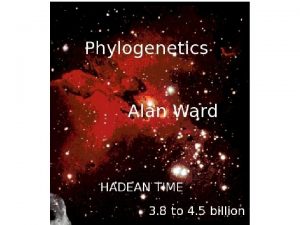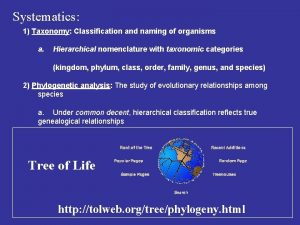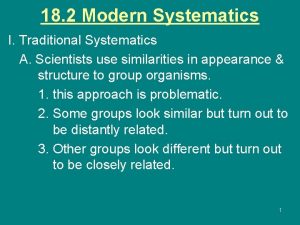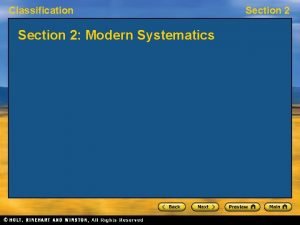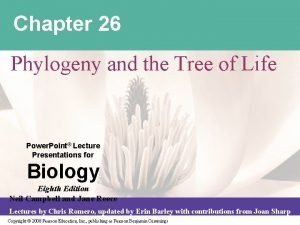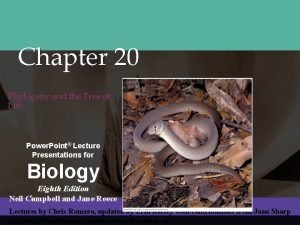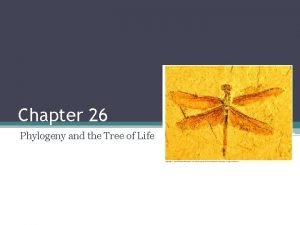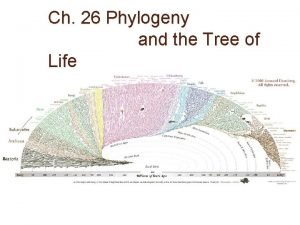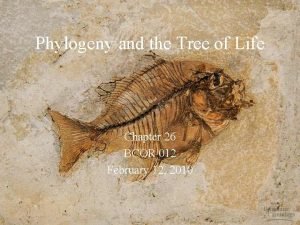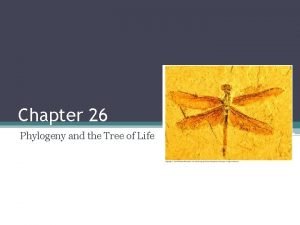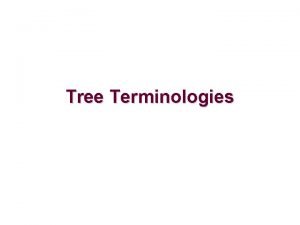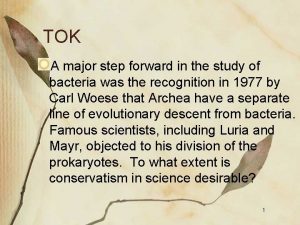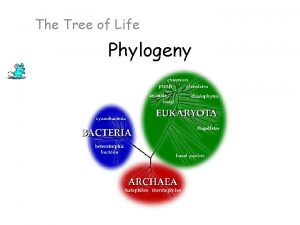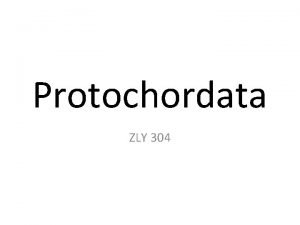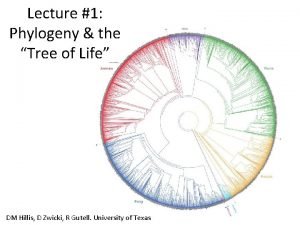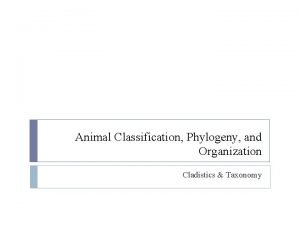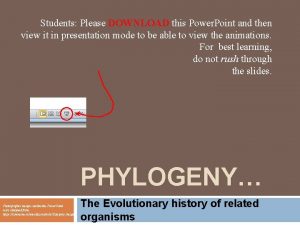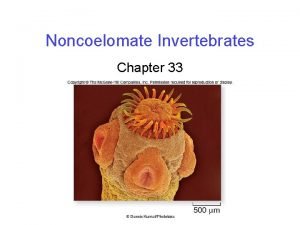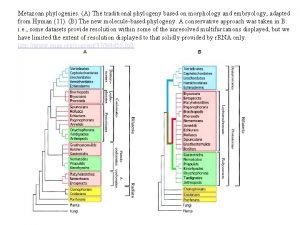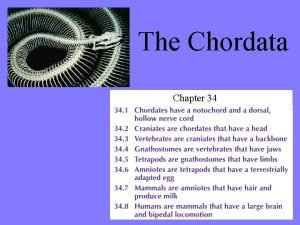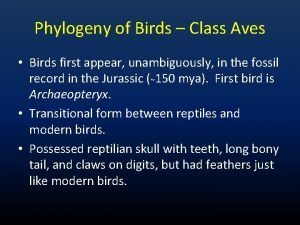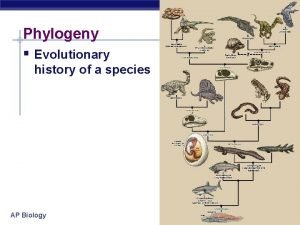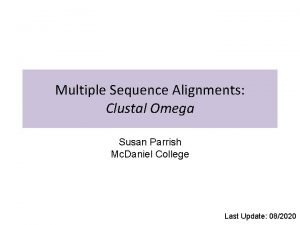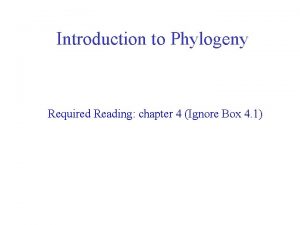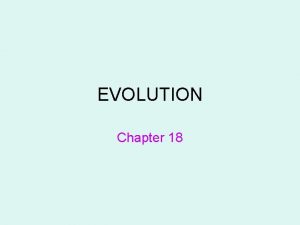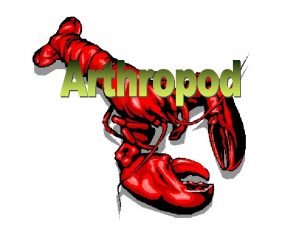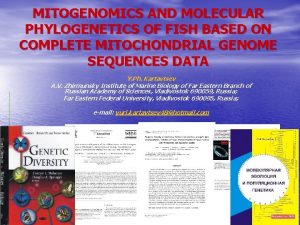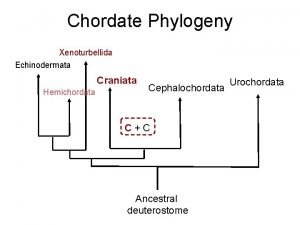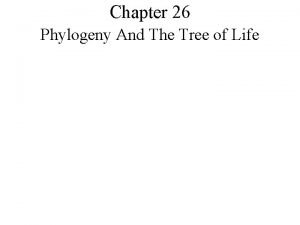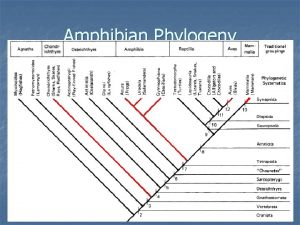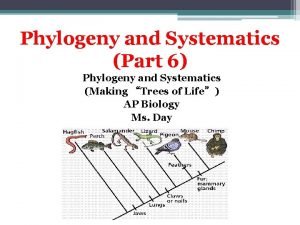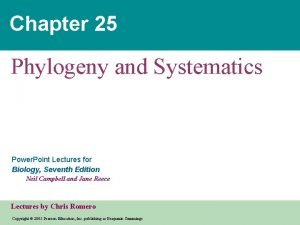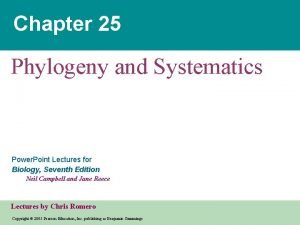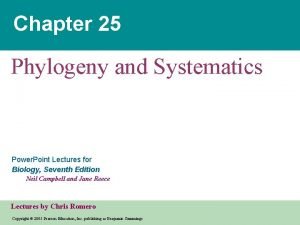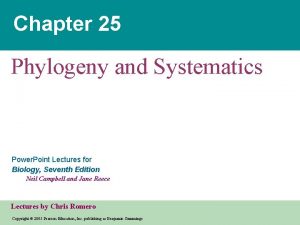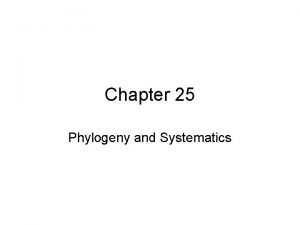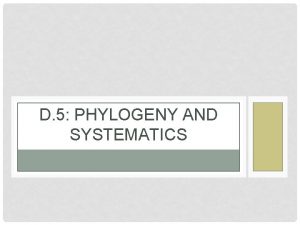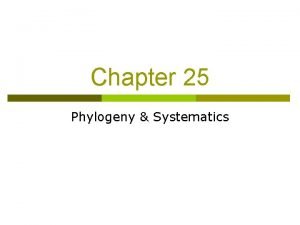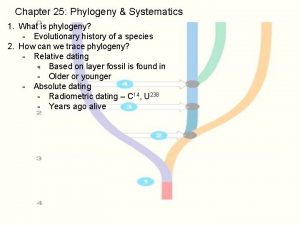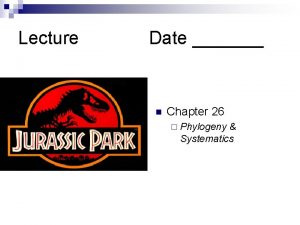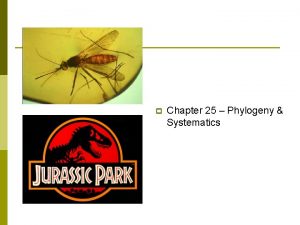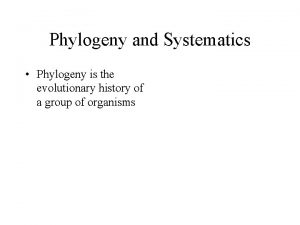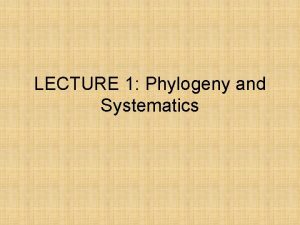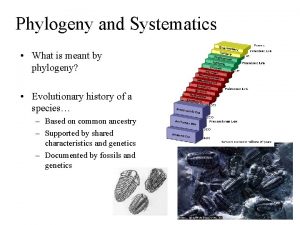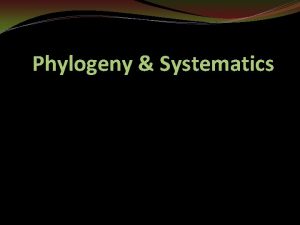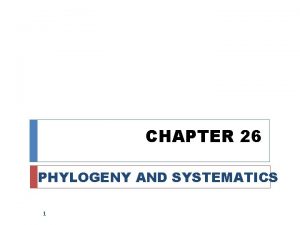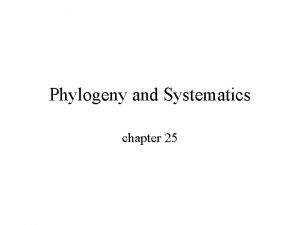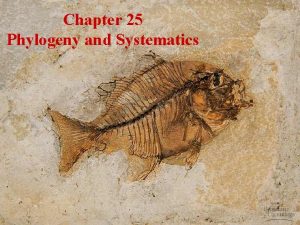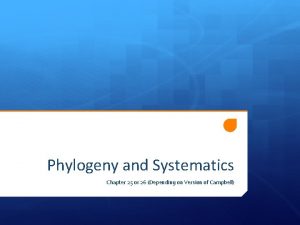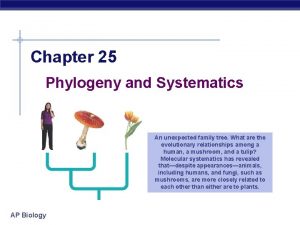Chapter 25 Phylogeny and Systematics Power Point Lectures






















































- Slides: 54

Chapter 25 Phylogeny and Systematics Power. Point Lectures for Biology, Seventh Edition Neil Campbell and Jane Reece Lectures by Chris Romero Copyright © 2005 Pearson Education, Inc. publishing as Benjamin Cummings

• Overview: Investigating the Tree of Life • This chapter describes how biologists trace phylogeny – The evolutionary history of a species or group of related species Copyright © 2005 Pearson Education, Inc. publishing as Benjamin Cummings

• Biologists draw on the fossil record – Which provides information about ancient organisms Figure 25. 1 Copyright © 2005 Pearson Education, Inc. publishing as Benjamin Cummings

• Biologists also use systematics – As an analytical approach to understanding the diversity and relationships of organisms, both present-day and extinct Copyright © 2005 Pearson Education, Inc. publishing as Benjamin Cummings

• Currently, systematists use – Morphological, biochemical, and molecular comparisons to infer evolutionary relationships Figure 25. 2 Copyright © 2005 Pearson Education, Inc. publishing as Benjamin Cummings

• Concept 25. 1: Phylogenies are based on common ancestries inferred from fossil, morphological, and molecular evidence Copyright © 2005 Pearson Education, Inc. publishing as Benjamin Cummings

The Fossil Record • Sedimentary rocks – Are the richest source of fossils – Are deposited into layers called strata 1 Rivers carry sediment to the ocean. Sedimentary rock layers containing fossils form on the ocean floor. 2 Over time, new strata are deposited, containing fossils from each time period. 3 As sea levels change and the seafloor is pushed upward, sedimentary rocks are exposed. Erosion reveals strata and fossils. Younger stratum ���with more recent fossils Figure 25. 3 Older stratum with older fossils Copyright © 2005 Pearson Education, Inc. publishing as Benjamin Cummings

• The fossil record – Is based on the sequence in which fossils have accumulated in such strata • Fossils reveal – Ancestral characteristics that may have been lost over time Copyright © 2005 Pearson Education, Inc. publishing as Benjamin Cummings

• Though sedimentary fossils are the most common – Paleontologists study a wide variety of fossils (c) Leaf fossil, about 40 million years old (b) Petrified tree in Arizona, about 190 million years old (a) Dinosaur bones being excavated from sandstone (d) Casts of ammonites, about 375 million years old (f) Insects preserved whole in amber Figure 25. 4 a–g (g) Tusks of a 23, 000 -year-old mammoth, frozen whole in Siberian ice Copyright © 2005 Pearson Education, Inc. publishing as Benjamin Cummings (e) Boy standing in a 150 -million-year-old dinosaur track in Colorado

Morphological and Molecular Homologies • In addition to fossil organisms – Phylogenetic history can be inferred from certain morphological and molecular similarities among living organisms • In general, organisms that share very similar morphologies or similar DNA sequences – Are likely to be more closely related than organisms with vastly different structures or sequences Copyright © 2005 Pearson Education, Inc. publishing as Benjamin Cummings

Sorting Homology from Analogy • A potential misconception in constructing a phylogeny – Is similarity due to convergent evolution, called analogy, rather than shared ancestry Copyright © 2005 Pearson Education, Inc. publishing as Benjamin Cummings

• Convergent evolution occurs when similar environmental pressures and natural selection – Produce similar (analogous) adaptations in organisms from different evolutionary lineages Figure 25. 5 Copyright © 2005 Pearson Education, Inc. publishing as Benjamin Cummings

• Analogous structures or molecular sequences that evolved independently – Are also called homoplasies Copyright © 2005 Pearson Education, Inc. publishing as Benjamin Cummings

Evaluating Molecular Homologies • Systematists use computer programs and mathematical tools – When analyzing comparable DNA segments from different organisms 1 Ancestral homologous DNA segments are identical as species 1 and species 2 begin to diverge from their common ancestor. 1 C C A T C A G T C C 2 C C A T C A G T C C Deletion 2 3 4 Figure 25. 6 Deletion and insertion mutations shift what had been matching sequences in the two species. Homologous regions (yellow) do not all align because of these mutations. Homologous regions realign after a computer program adds gaps in sequence 1. 1 C C A T C A G T C C 2 C C A T C A G T C C G T A Insertion 1 C C A T C A 2 C C A T G T A 1 2 A G T C C A T G T A C A G T C C C A G T C C Copyright © 2005 Pearson Education, Inc. publishing as Benjamin Cummings A C G G A T A G T C C A C T A G G C A C T A T C A C C G A C A G G T C T T T G A C T A G Figure 25. 7

• Concept 25. 2: Phylogenetic systematics connects classification with evolutionary history • Taxonomy – Is the ordered division of organisms into categories based on a set of characteristics used to assess similarities and differences Copyright © 2005 Pearson Education, Inc. publishing as Benjamin Cummings

Binomial Nomenclature • Binomial nomenclature – Is the two-part format of the scientific name of an organism – Was developed by Carolus Linnaeus Copyright © 2005 Pearson Education, Inc. publishing as Benjamin Cummings

• The binomial name of an organism or scientific epithet – Is latinized – Is the genus and species Copyright © 2005 Pearson Education, Inc. publishing as Benjamin Cummings

Hierarchical Classification • Linnaeus also introduced a system – For grouping species in increasingly broad categories Panthera Species pardus Panthera Genus Felidae Family Carnivora Order Class Phylum Kingdom Figure 25. 8 Domain Copyright © 2005 Pearson Education, Inc. publishing as Benjamin Cummings Mammalia Chordata Animalia Eukarya

Linking Classification and Phylogeny • Systematists depict evolutionary relationships Species Panthera Order Family Panthera Mephitis Canis Lutra lutra pardus mephitis familiaris lupus (European (leopard) (striped skunk) otter) (domestic dog) (wolf) Genus – In branching phylogenetic trees Mephitis Felidae Lutra Mustelidae Carnivora Figure 25. 9 Copyright © 2005 Pearson Education, Inc. publishing as Benjamin Cummings Canidae

• Each branch point – Represents the divergence of two species Leopard Domestic cat Common ancestor Copyright © 2005 Pearson Education, Inc. publishing as Benjamin Cummings

• “Deeper” branch points – Represent progressively greater amounts of divergence Wolf Leopard Common ancestor Copyright © 2005 Pearson Education, Inc. publishing as Benjamin Cummings Domestic cat

• Concept 25. 3: Phylogenetic systematics informs the construction of phylogenetic trees based on shared characteristics • A cladogram – Is a depiction of patterns of shared characteristics among taxa • A clade within a cladogram – Is defined as a group of species that includes an ancestral species and all its descendants • Cladistics – Is the study of resemblances among clades Copyright © 2005 Pearson Education, Inc. publishing as Benjamin Cummings

Cladistics • Clades – Can be nested within larger clades, but not all groupings or organisms qualify as clades Copyright © 2005 Pearson Education, Inc. publishing as Benjamin Cummings

• A valid clade is monophyletic – Signifying that it consists of the ancestor species and all its descendants Grouping 1 E D J H G F C K I B A Figure 25. 10 a (a) Monophyletic. In this tree, grouping 1, consisting of the seven species B–H, is a monophyletic group, or clade. A monophyletic group is made up of an ancestral species (species B in this case) and all of its descendant species. Only monophyletic groups qualify as legitimate taxa derived from cladistics. Copyright © 2005 Pearson Education, Inc. publishing as Benjamin Cummings

• A paraphyletic clade – Is a grouping that consists of an ancestral species and some, but not all, of the descendants Grouping 2 G E D C J H K I F B A Figure 25. 10 b (b) Paraphyletic. Grouping 2 does not meet the cladistic criterion: It is paraphyletic, which means that it consists of an ancestor (A in this case) and some, but not all, of that ancestor’s descendants. (Grouping 2 includes the descendants I, J, and K, but excludes B–H, which also descended from A. ) Copyright © 2005 Pearson Education, Inc. publishing as Benjamin Cummings

• A polyphyletic grouping – Includes numerous types of organisms that lack a common ancestor Grouping 3 D E G J H I F C K B A Figure 25. 10 c (c) Polyphyletic. Grouping 3 also fails the cladistic test. It is polyphyletic, which means that it lacks the common ancestor of (A) the species in the group. Furthermore, a valid taxon that includes the extant species G, H, J, and K would necessarily also contain D and E, which are also descended from A. Copyright © 2005 Pearson Education, Inc. publishing as Benjamin Cummings

Shared Primitive and Shared Derived Characteristics • In cladistic analysis – Clades are defined by their evolutionary novelties Copyright © 2005 Pearson Education, Inc. publishing as Benjamin Cummings

• A shared primitive character – Is a homologous structure that predates the branching of a particular clade from other members of that clade – Is shared beyond the taxon we are trying to define Copyright © 2005 Pearson Education, Inc. publishing as Benjamin Cummings

• A shared derived character – Is an evolutionary novelty unique to a particular clade Copyright © 2005 Pearson Education, Inc. publishing as Benjamin Cummings

Outgroups • Systematists use a method called outgroup comparison – To differentiate between shared derived and shared primitive characteristics Copyright © 2005 Pearson Education, Inc. publishing as Benjamin Cummings

• As a basis of comparison we need to designate an outgroup – which is a species or group of species that is closely related to the ingroup, the various species we are studying • Outgroup comparison – Is based on the assumption that homologies present in both the outgroup and ingroup must be primitive characters that predate the divergence of both groups from a common ancestor Copyright © 2005 Pearson Education, Inc. publishing as Benjamin Cummings

• The outgroup comparison – Enables us to focus on just those characters that were derived at the various branch points in the evolution of a clade Lamprey Tuna Salamander Turtle Leopard Hair 0 0 0 1 Amniotic (shelled) egg 0 0 1 1 Four walking legs 0 0 0 1 1 1 Hinged jaws 0 0 1 1 Vertebral column (backbone) 0 1 1 1 CHARACTERS Lancelet (outgroup) TAXA Turtle Salamander Tuna Lamprey Lancelet (outgroup) Figure 25. 11 a, b (a) Character table. A 0 indicates that a character is absent; a 1 indicates that a character is present. Leopard Hair Amniotic egg Four walking legs Hinged jaws Vertebral column Copyright © 2005 Pearson Education, Inc. publishing as Benjamin Cummings (b) Cladogram. Analyzing the distribution of these derived characters can provide insight into vertebrate phylogeny.

Phylogenetic Trees and Timing • Any chronology represented by the branching pattern of a phylogenetic tree – Is relative rather than absolute in terms of representing the timing of divergences Copyright © 2005 Pearson Education, Inc. publishing as Benjamin Cummings

Phylograms • In a phylogram – The length of a branch in a cladogram reflects the number of genetic changes that have taken place in a particular DNA or RNA sequence in that lineage hil op s ro a ib ia n ph Figure 25. 12 Copyright © 2005 Pearson Education, Inc. publishing as Benjamin Cummings se ou M at um R rd H Bi an Am Fi let ce n La sh D

Ultrametric Trees • In an ultrametric tree 251 542 Millions of years ago Copyright © 2005 Pearson Education, Inc. publishing as Benjamin Cummings rd Hu ma n R at M ou se Bi Am sh et Fi La nc el so ph ro D 65. 5 Cenozoic Mesozoic Paleozoic Proterozoic Figure 25. 13 ph ib ian The branching pattern is the same as in a phylogram, but all the branches that can be traced from the common ancestor to the present are of equal length ila –

Maximum Parsimony and Maximum Likelihood • Systematists – Can never be sure of finding the single best tree in a large data set – Narrow the possibilities by applying the principles of maximum parsimony and maximum likelihood Copyright © 2005 Pearson Education, Inc. publishing as Benjamin Cummings

• Among phylogenetic hypotheses – The most parsimonious tree is the one that requires the fewest evolutionary events to have occurred in the form of shared derived characters Copyright © 2005 Pearson Education, Inc. publishing as Benjamin Cummings

• Applying parsimony to a problem in molecular systematics Human 0 Mushroom Tulip 30% 0 Tulip Figure 25. 14 (a) Percentage differences between sequences Copyright © 2005 Pearson Education, Inc. publishing as Benjamin Cummings 40% 0

• Applying parsimony to a problem in molecular systematics 25% 15% 15% 20% 10% 5% 5% Tree 1: More likely Figure 25. 14 (b) Comparison of possible trees Copyright © 2005 Pearson Education, Inc. publishing as Benjamin Cummings Tree 2: Less likely

• The principle of maximum likelihood – States that, given certain rules about how DNA changes over time, a tree can be found that reflects the most likely sequence of evolutionary events APPLICATION In considering possible phylogenies for a group of species, systematists compare molecular data for the species. The most efficient way to study the various phylogenetic hypotheses is to begin by first considering the most parsimonious—that is, which hypothesis requires the fewest total evolutionary events (molecular changes) to have occurred. TECHNIQUE 1 Follow the numbered steps as we apply the principle of parsimony to a hypothetical phylogenetic problem involving four closely related bird species. First, draw the possible phylogenies for the species (only 3 of the 15 possible trees relating these four species are shown here). Species I I II I IV Species III Species II II I IV II IV Three possible phylogenetic hypothese 1 2 Tabulate the molecular data for the species (in this simplified example, the data represent a DNA sequence consisting of just seven nucleotide bases). Species Figure 25. 15 a 3 Now focus on site 1 in the DNA sequence. A single basechange event, marked by the crossbar in the branch leading to species I, is sufficient to account for the site 1 data. Copyright © 2005 Pearson Education, Inc. publishing as Benjamin Cummings Sites in DNA sequence 2 5 6 3 4 7 I A G G G T II G G G A G G G III G A G G A A T IV G G A A G I A II G III G G Base-change event IV G G G Bases at site 1 for each species III

4 Continuing the comparison of bases at sites 2, 3, and 4 reveals that each of these possible trees requires a total of four base-change events (marked again by crossbars). Thus, the first four sites in this DNA sequence do not help us identify the most parsimonious tree. 5 After analyzing sites 5 and 6, we find that the first tree requires fewer evolutionary events than the other two trees (two base changes versus four). Note that in these diagrams, we assume that the common ancestor had GG at sites 5 and 6. But even if we started with an AA ancestor, the first tree still would require only two changes, while four changes would be required to make the other hypotheses work. Keep in mind that parsimony only considers the total number of events, not the particular nature of the events (how likely the particular base changes are to occur). 6 At site 7, the three trees also differ in the number of evolutionary events required to explain the DNA data. I II GG GG III IV III AA IV AA I III GG AA AA GG GG III Two base changes GG I T I III T IV G T T Figure 25. 15 b Copyright © 2005 Pearson Education, Inc. publishing as Benjamin Cummings I II IV II GG IV AA I IV GG AA GG GG I IV I T III T 8 events IV II G IV G G T I III II GG III AA GG I T IV G III T T III II GG GG T RESULTS To identify the most parsimonious tree, we total all the base-change events noted in steps 3– 6 (don’t forget to include the changes for site 1, on the facing page). We conclude that the first tree is the most parsimonious of these three possible phylogenies. (But now we must complete our search by investigating the 12 other possible trees. ) II T II 9 events IV II 10 events III

Phylogenetic Trees as Hypotheses • The best hypotheses for phylogenetic trees – Are those that fit the most data: morphological, molecular, and fossil Copyright © 2005 Pearson Education, Inc. publishing as Benjamin Cummings

• Sometimes there is compelling evidence – That the best hypothesis is not the most parsimonious Bird Lizard Mammal Four-chambered heart (a) Mammal-bird clade Bird Lizard Mammal Four-chambered heart Figure 25. 16 a, b (b) Lizard-bird clade Copyright © 2005 Pearson Education, Inc. publishing as Benjamin Cummings

• Concept 25. 4: Much of an organism’s evolutionary history is documented in its genome • Comparing nucleic acids or other molecules to infer relatedness – Is a valuable tool for tracing organisms’ evolutionary history Copyright © 2005 Pearson Education, Inc. publishing as Benjamin Cummings

Gene Duplications and Gene Families • Gene duplication – Is one of the most important types of mutation in evolution because it increases the number of genes in the genome, providing further opportunities for evolutionary changes Copyright © 2005 Pearson Education, Inc. publishing as Benjamin Cummings

• Orthologous genes – Are genes found in a single copy in the genome – Can diverge only once speciation has taken place Ancestral gene Speciation (a) Figure 25. 17 a Orthologous genes Copyright © 2005 Pearson Education, Inc. publishing as Benjamin Cummings

• Paralogous genes – Result from gene duplication, so they are found in more than one copy in the genome – Can diverge within the clade that carries them, often adding new functions Ancestral gene Gene duplication Figure 25. 17 b (b) Paralogous genes Copyright © 2005 Pearson Education, Inc. publishing as Benjamin Cummings

Genome Evolution • Orthologous genes are widespread – And extend across many widely varied species • The widespread consistency in total gene number in organisms of varying complexity – Indicates that genes in complex organisms are extremely versatile and that each gene can perform many functions Copyright © 2005 Pearson Education, Inc. publishing as Benjamin Cummings

• Concept 25. 5: Molecular clocks help track evolutionary time Copyright © 2005 Pearson Education, Inc. publishing as Benjamin Cummings

Molecular Clocks • The molecular clock – Is a yardstick for measuring the absolute time of evolutionary change based on the observation that some genes and other regions of genomes appear to evolve at constant rates Copyright © 2005 Pearson Education, Inc. publishing as Benjamin Cummings

Neutral Theory • Neutral theory states that – Much evolutionary change in genes and proteins has no effect on fitness and therefore is not influenced by Darwinian selection – And that the rate of molecular change in these genes and proteins should be regular like a clock Copyright © 2005 Pearson Education, Inc. publishing as Benjamin Cummings

Difficulties with Molecular Clocks • The molecular clock – Does not run as smoothly as neutral theory predicts Copyright © 2005 Pearson Education, Inc. publishing as Benjamin Cummings

Applying a Molecular Clock: The Origin of HIV • Phylogenetic analysis shows that HIV – Is descended from viruses that infect chimpanzees and other primates • A comparison of HIV samples from throughout the epidemic – Has shown that the virus has evolved in a remarkably clocklike fashion Copyright © 2005 Pearson Education, Inc. publishing as Benjamin Cummings

The Universal Tree of Life • The tree of life – Is divided into three great clades called domains: Bacteria, Archaea, and Eukarya • The early history of these domains is not yet clear Billion years ago Bacteria Eukarya Archaea 0 4 Symbiosis of chloroplast ancestor with ancestor of green plants 1 3 Symbiosis of mitochondrial ancestor with ancestor of eukaryotes 2 Possible fusion of bacterium and archaean, yielding ancestor of eukaryotic cells 1 Last common ancestor of all living things 4 2 3 1 Figure 25. 18 4 Copyright © 2005 Pearson Education, Inc. publishing as Benjamin Cummings Origin of life
 Systematics vs taxonomy
Systematics vs taxonomy Taxonomy vs systematics
Taxonomy vs systematics Traditional systematics
Traditional systematics Systematics deals with
Systematics deals with Section 2 modern classification
Section 2 modern classification Monophyletic group
Monophyletic group Chapter 20 phylogeny and the tree of life
Chapter 20 phylogeny and the tree of life Phylogeny and the tree of life chapter 26
Phylogeny and the tree of life chapter 26 Homologies
Homologies Phylogeny and the tree of life chapter 26
Phylogeny and the tree of life chapter 26 Chapter 26 phylogeny and the tree of life
Chapter 26 phylogeny and the tree of life Power system lectures
Power system lectures Power triangle diagram
Power triangle diagram Informsu
Informsu Point point power
Point point power Utilities and energy lecture
Utilities and energy lecture What is text linguistics
What is text linguistics Molecular biology lectures
Molecular biology lectures Rooted vs unrooted phylogenetic tree
Rooted vs unrooted phylogenetic tree Outgroup in phylogeny
Outgroup in phylogeny Ingroup phylogenetic tree
Ingroup phylogenetic tree Photos
Photos Crab cladogram
Crab cladogram Kingdom plantae phylogenetic tree
Kingdom plantae phylogenetic tree Taxa phylogenetic tree
Taxa phylogenetic tree Animal kingdom cladogram
Animal kingdom cladogram Phylogeny
Phylogeny Cladistics
Cladistics Phylogeny
Phylogeny Classification of platyhelminthes
Classification of platyhelminthes Metazoan phylogeny
Metazoan phylogeny Shark chapter 34
Shark chapter 34 Dinosauria
Dinosauria Ap biology phylogeny
Ap biology phylogeny Omega sequence alignment
Omega sequence alignment Artiodactyla phylogeny
Artiodactyla phylogeny Ontogeny recapitulates phylogeny
Ontogeny recapitulates phylogeny Arthropoda phylogeny
Arthropoda phylogeny Fish phylogeny
Fish phylogeny Chordate
Chordate Phylogeny is the study of _____.
Phylogeny is the study of _____. Conus arteriosus
Conus arteriosus Rick trebino
Rick trebino Lectures paediatrics
Lectures paediatrics Data mining lectures
Data mining lectures Advanced medicinal chemistry
Advanced medicinal chemistry Uva orthopaedics
Uva orthopaedics Ludic space
Ludic space Activity based approach in software project management
Activity based approach in software project management Radio astronomy lectures
Radio astronomy lectures Dr sohail lectures
Dr sohail lectures Introduction to web engineering
Introduction to web engineering How to get the most out of lectures
How to get the most out of lectures Frcr physics lectures
Frcr physics lectures Frequency of xrays
Frequency of xrays
